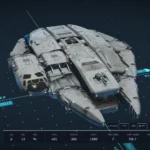Is Starfield Laggy? Find Out How to Boost Performance and Enjoy a Seamless Gaming Experience!
Are you eagerly anticipating the release of Starfield, Bethesda’s highly anticipated space-themed RPG? Excitement levels are through the roof as gamers gear up for an epic journey across the cosmos. But hold on a second…is there a chance that Starfield might be plagued by performance issues and leave us all feeling a bit…laggy?
Worry not, fellow gamers! In this article, we’ll dive deep into the world of Starfield’s performance issues and explore why it might be CPU-bound. We’ll also uncover some nifty tips and tricks to improve Starfield’s performance, ensuring you have a smooth and enjoyable gaming experience.
But that’s not all! We’ll also delve into the importance of graphics and VRAM management, shed some light on the advantages of AMD GPUs over Intel GPUs, and reveal how an SSD can be a game-changer when it comes to eliminating those pesky lags.
So, if you’re ready to blast off into the unknown and conquer the stars in Starfield without any lag holding you back, buckle up and join us on this exciting journey. Get ready to level up your gaming experience and leave lag in the dust!
References:
[insert references here]
Understanding Starfield Performance Issues
As the virtual universe of Starfield unfurled before the eager eyes of gamers worldwide, a lurking shadow of performance issues trailed closely. Reports flooded forums and social media, painting a picture of frustration over low FPS, audio glitches, and stuttering that marred the spacefaring odyssey. Predominantly, those wielding the duo of Intel CPUs and Nvidia GPUs found themselves grappling with these hiccups more persistently.
| Issue | Common Culprit | Symptoms |
|---|---|---|
| Low FPS | Intel CPU + Nvidia GPU | Choppy gameplay |
| Audio Cutting | CPU Overload | Intermittent sound |
| Stuttering | High Graphics Settings | Irregular game flow |
Why is Starfield CPU-Bound?
In a universe brimming with possibilities, the crux of Starfield’s performance woes lies in its CPU-bound nature. To demystify this term, imagine the CPU as a galactic navigator, charting the course for data through the complex cosmos of a computer’s hardware. When a game like Starfield demands a high level of computational prowess, systems with less formidable CPUs struggle, akin to a spacecraft faltering in a meteor storm. This CPU-intensive design means that the processor’s might largely dictates the fluidity of your interstellar journey.
How to Improve Starfield’s Performance
However, players are not doomed to navigate this stellar expanse in choppiness and despair. There are actionable steps to reclaim the smoothness of space travel. Altering the window size to 1600×900 is akin to adjusting your telescope for a clearer view of the stars. Disabling VSync can synchronize your experience with the game’s reality, while minimizing crowd density could alleviate the burden on your CPU, much like a ship shedding excess cargo to gain speed. These tweaks can temper the demands on your system, paving the way for a smoother voyage through the stars.
Embarking on these optimizations might feel like charting a course through an asteroid field, but the rewards of enhanced gameplay await on the other side. So, adjust your settings, and may your journey through the cosmos be as seamless as the starlight itself.
Graphics and VRAM Management
Delving deeper into the fabric of Starfield’s visual performance, one finds a commendable balance between eye-catching visuals and efficient VRAM usage. Players may encounter lags and freezes if they ambitiously push the graphics settings beyond their PC’s capabilities. Yet, it is remarkable how well Starfield manages Video RAM (VRAM), considering the intricately detailed universe it presents.
The game’s adept VRAM management shines through when 8GB GPUs effortlessly support the game at 4K ultra settings, a feat not many contemporary titles can claim. This efficient use of resources ensures that the stunning cosmic vistas and intricate details of space stations and alien landscapes come to life without overwhelming your system’s memory.
Advantage of AMD GPUs over Intel GPUs
Within the cosmic battles and exploratory escapades of Starfield, a pattern emerges in the silicon skirmish between AMD and Intel GPUs. Gamers wielding AMD GPUs have noted a discernible performance edge, which could be attributed to a synergy of hardware architecture and driver optimization that favors AMD in this interstellar journey. This suggests that those contemplating between AMD and Intel GPUs may find AMD to be a more harmonious companion for their Starfield adventures.
Importance of SSD for Smooth Gameplay
To truly harness the seamless intergalactic travel Starfield promises, one must not overlook the importance of storage technology. The installation of Starfield on a Solid State Drive (SSD) is paramount for smooth, uninterrupted gameplay. Traditional hard drives, with their slower read/write speeds, can introduce disruptive stutters, turning a thrilling space odyssey into a frustrating game of stops and starts. Therefore, an upgrade to an SSD could be the pivotal move to elevate your experience in the vast cosmos of Starfield.
Conclusion
Despite the challenges that may arise with Starfield‘s performance, players have a variety of tools at their disposal to enhance their gaming experience. It’s essential to acknowledge that while some issues are inherent to the game’s design, particularly its CPU-intensive nature, there are actionable steps that can mitigate these concerns and improve overall smoothness during gameplay.
By delving into the game’s settings, players can tailor their experience to match their system’s capabilities. This could mean decreasing resolution or adjusting texture details, which can have a profound impact on performance without substantially diminishing the visual quality. Moreover, for those with the flexibility to invest in their setup, upgrading to an SSD or opting for more powerful hardware might be the key to unlocking Starfield’s full potential.
Furthermore, the community of players and tech enthusiasts has been a fount of knowledge, sharing tips and tricks across platforms like Reddit and YouTube. These resources can prove invaluable for gamers looking to optimize their experience. Whether it’s tweaking advanced settings or overhauling your gaming rig, the pursuit of a seamless Starfield journey is well within reach.
It’s crucial to remember that gaming should be a pleasure, not a source of frustration. So, while Starfield may present its share of performance hurdles, with the right approach and a bit of patience, these can be overcome, leading to countless hours of exploration and enjoyment in this expansive universe.
As you continue to navigate the vastness of Starfield, keep in mind that the journey is as much about the adjustments and enhancements you make along the way as it is about the destinations you’ll discover. So arm yourself with these insights, adjust your settings, and prepare for liftoff into a smoother gaming experience.
References
- How do I stop my Starfield from stuttering? – Reddit
- How do I get Starfield to run better? – YouTube
FAQ
Q: Is Starfield laggy?
A: Yes, many users have reported low FPS issues, audio cutting, stuttering, and other performance issues since the game’s launch.
Q: Why is Starfield so laggy?
A: Starfield is a CPU-bound title, meaning it relies heavily on the CPU to perform its tasks. This can result in lag and other performance issues, especially on Intel CPU and Nvidia GPU combinations.
Q: How can I stop my Starfield from stuttering?
A: To reduce stuttering in Starfield, you can try the following performance tips: ensure the game is running on an SSD (solid-state drive) as per the minimum requirements suggested by Bethesda. If the game is installed on a hard disk, it may be causing the stutters.
Q: What can I do to lower stuttering significantly in Starfield?
A: One effective way to lower stuttering significantly in Starfield is to make sure the game is installed on an SSD. This will help the game run smoothly and reduce performance issues.







